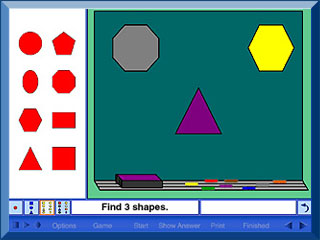
Introduce your students to counting, colors, size, and basic geometric shapes. This CD teaches 10 shapes, 10 colors, counting by ones to 50, counting by multiples to 100, visual perceptual discrimination of shapes, colors, numbers and the concepts of small, medium, and large.
Target Audience: Appropriate for K–2nd grade for teaching basic math concepts to neurotypical toddlers, kindergarteners, as well as older children with Autism, PDD, Down Syndrome, Cerebral Palsy, comprehension problems, weak visual memory skills.
Everyday Language I
by LocuTour Multimedia
Windows Only
Information for Professionals:
The CD provides the opportunity to develop receptive/expressive language skills, rapid automatic naming, visual scanning, visual perceptual discrimination, figure ground discrimination, auditory discrimination, auditory memory, verbal rehearsal strategies, reasoning and planning skills.
The objectives of this CD are to teach 10 shapes, 10 colors, counting by ones to 50, counting by multiples to 100, visual perceptual discrimination of shapes, colors, numbers and the concepts of small, medium, and large.

Who am I? teaches the shapes, colors and numbers included on the CD then quizzes the student with the “Who Am I?” prompt.
The student learns 10 basic shapes (triangle, square, rectangle, circle, oval, point, line, pentagon, hexagon, octagon), 10 common colors (brown, gray, purple, orange, blue, black, yellow, green, white, red), and numbers from 1 to 10. The student practices expressive language skills by saying and recording the target word in isolation, phrases or sentences.
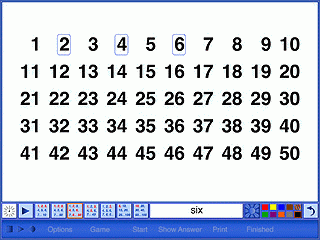
Count Along presents the numbers 1-50 in sequence, counting by even or odd, and skip counting by 3’s, 5’s or 10’s to 100. After the counting, the student is challenged to find the numbers before the timer runs out.
The student must maintain attention while visually scanning the numbers left to right, top to bottom as they are labeled by the computer. The student listens and/ or reads the number, remembers the number and selects the target number from a field of numbers (10-100), in sequence up to 100.
The computer handles errors by labeling the number chosen, then redirecting attention to the target number by repeating the target number with the phrase, “You’re looking for...”.

Quick! What’s My Name? is a confrontation naming task allows the student to practice Rapid Automatic Naming of colors, numbers and shapes.
Rapid Automatic Naming (RAN) of letters has been identified as a predictor of literacy competence (Blachman, 1984). We hypothesize that there may also be a correlation between shape, color and number naming skills associated with numeracy. Therefore, we suggest the student practice rapid naming within categories (all numbers, all colors, etc.) and between categories (Mixed in Color level). The RAN feature automatically records speech. It is possible to use this RAN page as a template for “if/then” prompts. The instructor and student can make up commands such as, “If the red triangle is after the blue circle say the word, “triangle”.”
Quick! What’s My Name? can be played as a Rapid Automatic Naming (RAN) task which requires competence in semantic memory, working memory and attention. This verbal fluency activity of confrontational naming is an important pre-literacy skill as well as a necessary step for establishing mathematical concepts.
The student will maintain auditory attention then use efficient scanning strategies to locate one item in a field of 10 to 30 items after an auditory prompt to, “Find ___.” RAN Level: The student will rapidly name 10 to 30 target stimuli when presented with visual prompts.
Ten to 30 items will be displayed one at a time. The student should name them as they appear then click on the item to confirm the name. After all items have been named, the “Find ___.” prompt begins and the computer starts the countdown. The countdown time can be set in Options. The computer will ask the student to find items until time is up or all items have been found.
RAN Level (Rapid Automatic Naming). Click on the RAN button then double click on any one of the content buttons from the Content Bar or single click on a content button and click Start to begin. Orange highlighted buttons indicate the levels are “on”. All of the objects will appear on the screen. The record feature turns on automatically, and the student is to begin naming the items in sequence from left to right and top to bottom. The timer will continue to time as long as the Record button is red. To stop timing, hit the Stop button. The total time elapsed is shown in minutes/seconds in the time box. There is no “Find” prompt in the RAN Level.
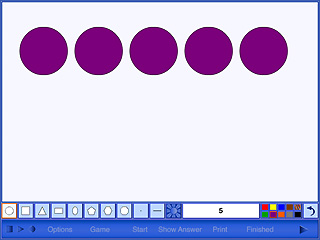
Shape Counters helps the student learn to distinguish basic shapes and to count shapes when presented in a set.
The student is required to sustain auditory attention to learn basic shape identification. Students practice expressive language skills by counting to 10.
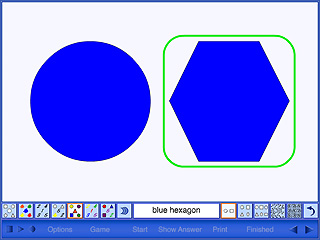
Find Me develops efficient visual scanning skills by directing the student to find a specific target in an increasingly complex field of foils.
Target categories are:
Set the number of items appearing on the screen by clicking one of the level buttons on the right side of the Content Bar. Options available are 2, 4 , 6, 35, or many items.
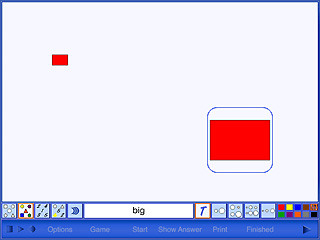
Size It Up defines the differences between small, medium and large shapes and gives the student practice in finding the correct target.
The student learns to isolate the feature “size” and ignore irrelevant features of color, number or shape.
Auditory and visual stimuli are presented, “Find big”, and the student is to find the target in a gradually increasing field of objects. The student scans from left to right and top to bottom to find the target, then clicks on it.
Make the task “visual only” by turning off the volume. Make the task “auditory only” by selecting Hidden in the Target Text in Menu Bar. Use the Options menu to set Pause On Correct and Pause On Error to allow discussion of responses.
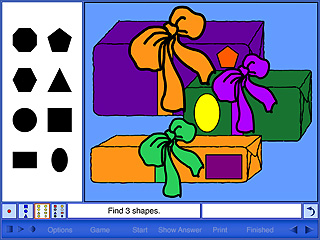
Shape Hunters places the target shape inside a picture. The student needs to search the picture and find the matching target.
The student learns to identify and match 10 different shapes and to ignore the irrelevant features of size and color when there are interfering background foils.
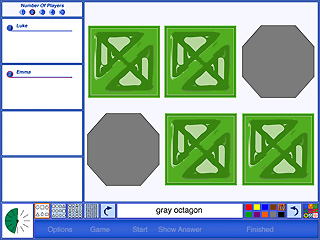
Match Ups! continues with the color, number, shape theme and places the targets in the concentration-like game of matching pairs. The number of cards to find ranges from 6-48.
The student encodes object or numeric information into working memory and demonstrates accurate retrieval of information using a matching task.
The student will learn how to use auditory and visual planning strategies for efficient retrieval.